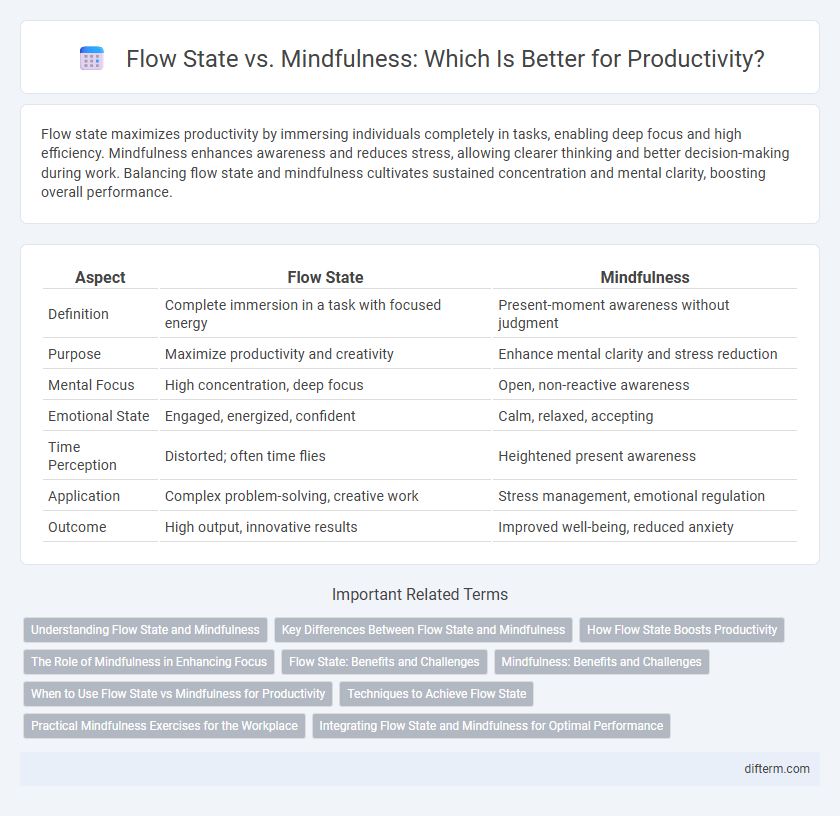Flow state maximizes productivity by immersing individuals completely in tasks, enabling deep focus and high efficiency. Mindfulness enhances awareness and reduces stress, allowing clearer thinking and better decision-making during work. Balancing flow state and mindfulness cultivates sustained concentration and mental clarity, boosting overall performance.
Table of Comparison
| Aspect | Flow State | Mindfulness |
|---|---|---|
| Definition | Complete immersion in a task with focused energy | Present-moment awareness without judgment |
| Purpose | Maximize productivity and creativity | Enhance mental clarity and stress reduction |
| Mental Focus | High concentration, deep focus | Open, non-reactive awareness |
| Emotional State | Engaged, energized, confident | Calm, relaxed, accepting |
| Time Perception | Distorted; often time flies | Heightened present awareness |
| Application | Complex problem-solving, creative work | Stress management, emotional regulation |
| Outcome | High output, innovative results | Improved well-being, reduced anxiety |
Understanding Flow State and Mindfulness
Flow state is a mental condition characterized by complete immersion and heightened focus on a task, leading to elevated productivity and creativity. Mindfulness involves maintaining present-moment awareness with non-judgmental attention, enhancing emotional regulation and reducing stress. Understanding the distinctions between flow state's deep engagement and mindfulness's conscious awareness can optimize strategies for sustained productivity and mental clarity.
Key Differences Between Flow State and Mindfulness
Flow state is characterized by intense concentration and full immersion in a task, resulting in peak productivity and loss of self-awareness, while mindfulness centers on non-judgmental awareness of the present moment, promoting calmness and emotional regulation. Flow demands a balance of challenge and skill, leading to effortless action, whereas mindfulness encourages acceptance and observation without engaging in specific activities. The key difference lies in flow's goal-directed absorption versus mindfulness's receptive, contemplative awareness, both enhancing productivity through distinct cognitive mechanisms.
How Flow State Boosts Productivity
Flow state enhances productivity by enabling deep immersion and heightened concentration, allowing tasks to be completed more efficiently and with greater accuracy. This optimal psychological state minimizes distractions and accelerates learning, resulting in improved performance and creative problem-solving. Sustaining flow fosters continuous engagement and motivation, driving consistent progress toward goals.
The Role of Mindfulness in Enhancing Focus
Mindfulness enhances focus by training the brain to remain present, reducing distractions and mental clutter that disrupt flow state. Regular mindfulness practice strengthens attention regulation, enabling sustained concentration crucial for entering and maintaining flow. This intentional awareness improves productivity by fostering a balanced mental environment where focus thrives seamlessly.
Flow State: Benefits and Challenges
Flow state enhances productivity by fostering deep immersion and heightened focus, leading to improved creativity and task efficiency. Benefits include increased motivation, accelerated learning, and a sense of fulfillment, while challenges involve difficulty in achieving flow consistently and potential neglect of self-care. Mastering flow state requires balancing intense concentration with mindfulness practices to maintain overall well-being and sustained performance.
Mindfulness: Benefits and Challenges
Mindfulness enhances productivity by fostering sustained attention and reducing stress through present-moment awareness, which improves cognitive flexibility and emotional regulation. Practicing mindfulness can decrease workplace distractions and increase resilience, leading to higher-quality decision-making and creativity. Challenges include the need for consistent practice and overcoming initial resistance or misconceptions about mindfulness, which may affect its integration into daily work routines.
When to Use Flow State vs Mindfulness for Productivity
Flow state enhances productivity during tasks requiring deep concentration, creative problem-solving, and sustained attention, making it ideal for complex projects and intense work sessions. Mindfulness suits moments needing stress reduction, mental clarity, and present-moment awareness, which improves decision-making and emotional regulation during breaks or preparation phases. Choosing flow state or mindfulness depends on the task's cognitive demands and the individual's need for focus versus relaxation.
Techniques to Achieve Flow State
Techniques to achieve flow state include setting clear goals, balancing challenge with skill level, and minimizing distractions to maintain deep concentration. Incorporating time-blocking methods and immediate feedback helps sustain engagement and optimize productivity. Physical practices like controlled breathing and short breaks enhance cognitive function, enabling prolonged periods of flow.
Practical Mindfulness Exercises for the Workplace
Practical mindfulness exercises such as focused breathing, body scans, and brief meditation sessions enhance productivity by reducing stress and increasing attention in the workplace. These techniques complement flow state by grounding employees in the present moment, fostering sustained concentration and deep work. Implementing regular mindfulness breaks improves cognitive flexibility, emotional regulation, and overall job performance.
Integrating Flow State and Mindfulness for Optimal Performance
Integrating flow state and mindfulness enhances productivity by combining deep immersion with present-moment awareness, allowing individuals to maintain intense focus while reducing stress. Flow state optimizes task engagement, whereas mindfulness fosters emotional regulation and clarity, together driving sustained high performance. This synergy supports effective decision-making, creativity, and resilience in demanding work environments.
Flow State vs Mindfulness Infographic

 difterm.com
difterm.com